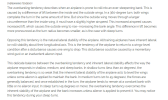Crashnburn
Pattern Altitude
I know adverse yaw is the nose moving in the opposite direction of the turn when you use ailerons to bank into a turn..
My first instructor said it was because the outside turn aileron moves down into denser air so creates more drag than the inside aileron moving up into less dense air (Bernoulli).
This FBO says the increased drag comes from the outside aileron moving down and creating more lift, which causes induced drag. That was my answer yesterday on my Ground part of the check ride.
I didn't think to ask, but what about what happens with the inside turn aileron moving up?
Does it kill lift by channeling the air up, so induced drag decreases, if not disappears?
My first instructor said it was because the outside turn aileron moves down into denser air so creates more drag than the inside aileron moving up into less dense air (Bernoulli).
This FBO says the increased drag comes from the outside aileron moving down and creating more lift, which causes induced drag. That was my answer yesterday on my Ground part of the check ride.
I didn't think to ask, but what about what happens with the inside turn aileron moving up?
Does it kill lift by channeling the air up, so induced drag decreases, if not disappears?

